IRON AWE and the Polar Express
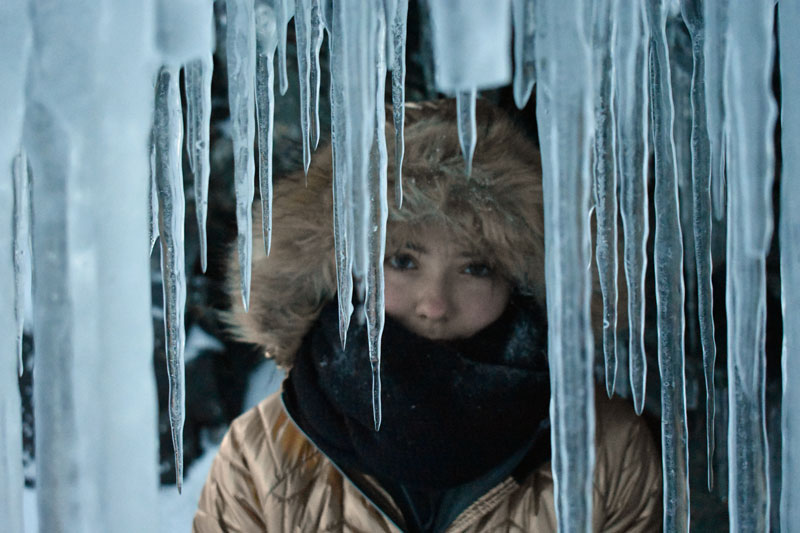
Scandinavia’s most northerly railway was built to carry iron ore. But, as JOHN GIMLETTE discovers, it also provides easy access to a vast and largely pristine wilderness.
At 540m underground, a new world appears. Deep below Kiruna, there’s no sound, and everything smells of rock. It’s easy to forget that, up on the surface, it’s -15?C and the sky is streaked in green. Down here, roads take off in all dimensions, and there are nine different trains snaking through the mountain. I remember thinking how odd it was to find a café so deep in the earth, and to be arriving by bus.
Had we descended another 500m, we’d have been in the thick of it. At that level, remote-controlled tractors shovel up enough ore each day to build six Eiffel Towers. This is now the world’s largest underground iron mine, supplying 78% of Europe’s needs. Listen carefully, and every morning in Kiruna, at about 1am, you’ll hear a reassuring rumble. It’s the explosive charges, loosening the ore that will become our cities and cars.
The iron mines of northern Sweden have also left us with a remarkable journey. Without them, there would probably be little access to this magnificent, watery wilderness. Being 200km inside the Arctic Circle, everything freezes from October to May, and there are few roads. In the early days, the ore had to be dragged out on sledges. But then, in 1884, an English company began a railway, and despite bankruptcy and the unforgiving ice, a lonely network eventually appeared. Even today, most of it is still single-track.
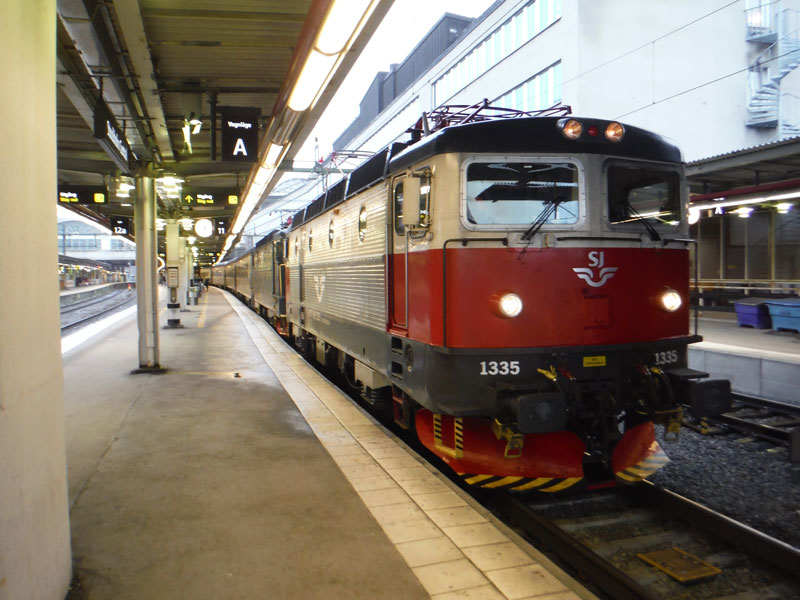
Known as the Malmbanen (or ‘Ore Line’), I could see the railway on my map, arcing across northern Scandinavia. This was the way to see Lapland, I decided. My wife and daughter, Lucy, needed little persuading. Dressed in all our ski-kit, we flew to the Norwegian port of Narvik, at 68?N. Here, we’d begin our week-long journey, linking up with the Malmbanen in Sweden. There would then be two stops along the way, to explore the wilds. Finally, from Kiruna, we’d catch the overnight ‘Arctic Circle Train’, veering south 1,400km to Stockholm.
Narvik was full of surprises. At night, everything lit up (even the ski-slopes), and, from up on the mountainside, it looked fleetingly grand. But, close-up, the houses were fretted and quaint, and painted in Shaker-like colours. Our hotel, however, was a miniature skyscraper (called The Scandic), and from its penthouse bar, we could watch the ore trains coming in, 68 wagons at a time. During the night, a strong wind got up, and a herd of moose came into town. No-one minded them, or the fact that it never got truly light. A local guide, Paula, took us on a twilight walk through lunchtime Narvik. ‘We won’t see the sun,’ she said, ‘for another six weeks.’
The fiord was as black as ink but, thanks to The North Atlantic Current, it never freezes. That’s why most of Sweden’s ore comes this way: 25 million tons a year. Back in 1940, all this iron was feeding Nazi aggression, and, that April, they captured Narvik. The allies retook it on 29 May, only to abandon Norway a few days later. In this desperate struggle, 8,500 lives were lost, along with 64 ships. ‘You can still see wrecks,’ said Paula, ‘out in the fiord.’ Other relics of that time have ended up in an inspired new venue: the Krigsmuseum. As well as a huge torpedo (which re-surfaced in 2011), we spotted some horses’ snowshoes, and – more mysteriously – a British pith helmet.
On our second day, we set off for Sweden. Like all the other stations, Narvik didn’t seem to have any staff, just a large stuffed wolverine caught in mid-snarl. Once aboard, however, the train was thrillingly old-fashioned and Nordic. The ‘bistro’ was panelled in art deco, and there were separate compartments for people with dogs. Outside all was black, so the staff settled down with a phone to watch the ice-hockey. But then, as we climbed into Sweden, the sparks from our wheels lit up the frozen forest, a brilliant stroboscopic blue.
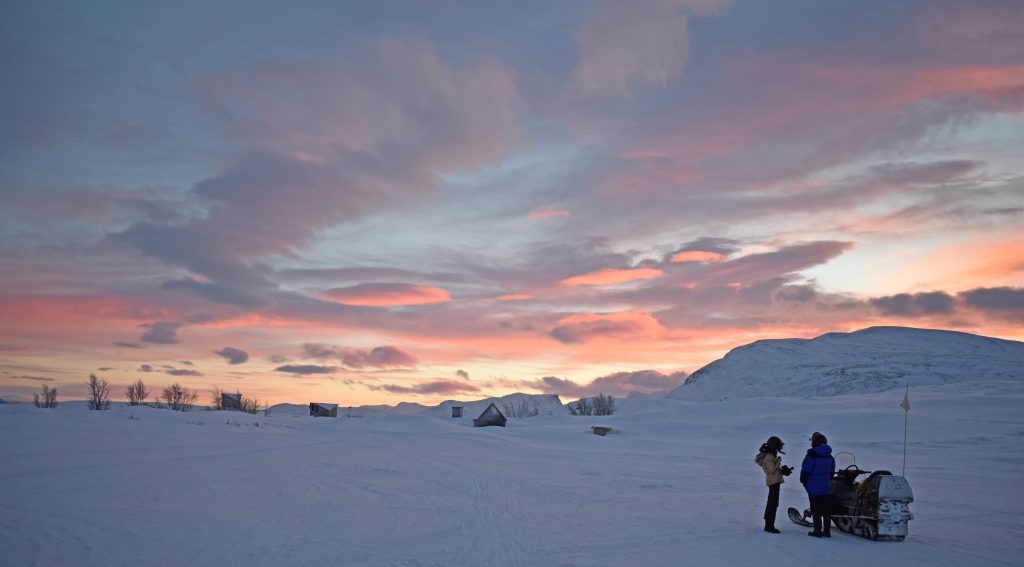
A little over an hour later, we arrived at Björkliden. Our hotel was perched on the mountainside, just above the track. A resort since 1926, the Hotell Fjället would become a refugee camp for Norwegians in 1940. Then, after the war, it was burnt down and completely rebuilt. Although still true to its log-cabin roots, it’s now as opulent as ever. As well as huge log-fires and a lavishly-pelted lounge, it enjoys 24km of ski trails (both downhill and cross-country) and its own little fleet of snow-mobiles. With Arctic char for dinner and deliciously tart lingonberries for breakfast, the Fjället is like a modern-day Valhalla, a place to unleash your inner Swede.
Best of all, during the brief episodes of daylight, a magnificent lake appeared. Frozen solid, Torneträsk was like a sweep of petrified sky, constantly changing colour. From our cabin, we could see the ore-trains clanking their way carefully round the edge. One morning, we padded down through the woods and onto the ice. It seems that, as the freezing waves had hit the shore, the spray had solidified, creating enormous Medusas and monsters, perhaps 6 metres high. The opposite shore was 12km away, and was said to be a last resort of bears and wolves. It was an intriguing idea: this fabulous Arctic landscape with another wilderness – ever wilder – deep within.
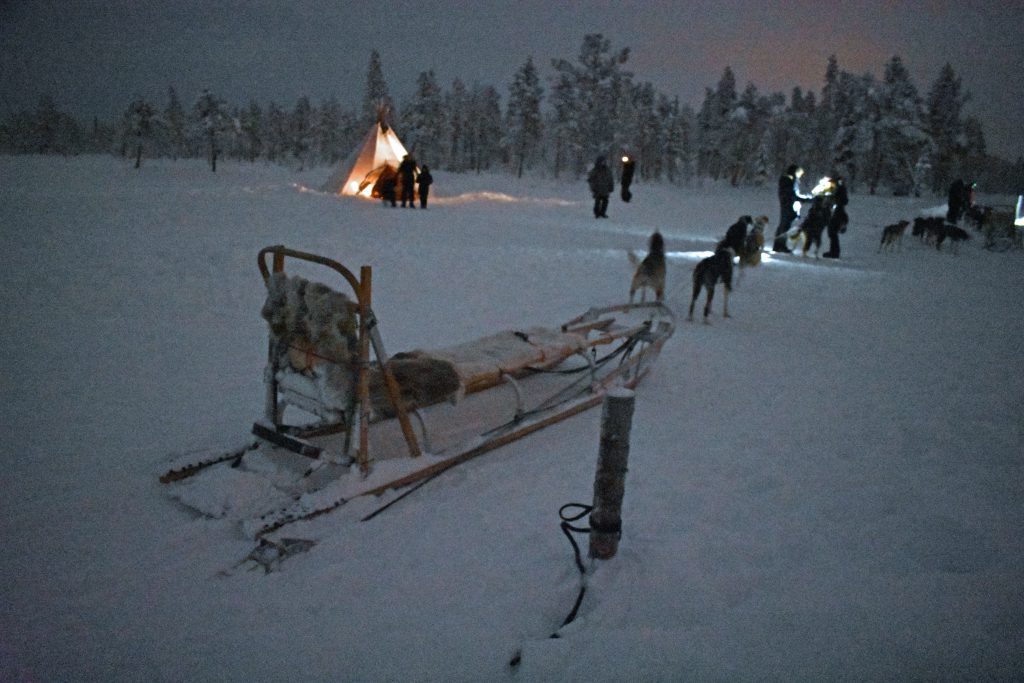
Each day, we’d set off on a mini-adventure. Twice we put on snow-shoes, and joined a guide, pounding over the foothills of Mount Låktatjåkka. These hikes would end with a campfire and coffee, brewed in the style of the local herders (boiled like tar, and stirred with a burnt twig). Another time, we took the snow-mobiles out. At 13, Lucy was too young to steer, but was happy riding pillion. It was like flying round the mountain on a plane without wings.
Our second night was the most spectacular. After dinner, we borrowed snow-boots and set off up Låktatjåkka, which had somehow come alive. In the moonlight, the trees sparkled like chandeliers, and we saw plump white grouse and a fox stalking through the drifts. But then, just before midnight, we reached a plateau, and the sky changed. Great smudges of colour appeared, and a brilliant halo of green. It was, of course, Aurora Borealis, putting on the biggest and most mysterious lightshow on Earth.
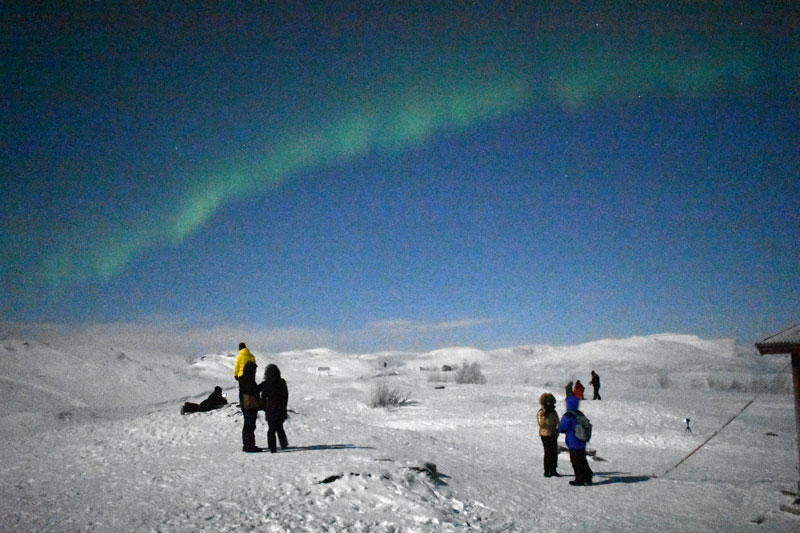
We were sorry to leave, but there was still Kiruna to come. Ninety minutes down the line, it may not have sounded much (a mining town, despatching eleven gigantic trains a day). But Kiruna had its charms. It wasn’t just a hub of wilderness life (with shops selling rifles, camp-kettles and Arctic workwear); the older parts were also often painted and pretty, and our hotel, ‘Camp Ripan’, had an alluring spa. Meanwhile, in the dark, the mine – now a blaze of lights – looked like some great, Supergalactic cruise ship, moored in the snow. Naturally, we followed the wagons back to their source, and took a tour inside.
It’s funny to think that much of this town will soon disappear. Thanks to subsidence (caused by the mine), old Kiruna has a journey ahead. Many of the buildings will be bulldozed, but some – like the church of 1912 – will be dismantled and rebuilt 3km out to the east. At the mine, they told us that some 3,000 homes would be relocated (at a cost to the company of around £320m). But the new Kiruna, it seems, will be a Space-Age place. Already its outline is taking shape, beginning with the kerbstones and sewers.
Half an hour down the road by taxi, we came across a rather more enduring community. These days, the village of Jukkäsjarvi is best known for ‘The Icehotel’ with its short-lived and deliciously zany sculptures (think astronauts and mermaids). But, for the semi-nomadic Sámi people, Jukkäsjarvi signifies permanence, and they’ve been meeting here for centuries. The little red church that the Christians sent them in 1608 is still there, as alluring as ever. Next door is the Sámi museum. Its exhibits suggest a gruelling existence: wooden mugs, tiny larders, and suits made of skins. Round the back, there were even a few reindeer. They looked edgy and querulous at first, but, as Lucy discovered, they’ll do almost anything for a mouthful of lichen.
Our last evening, we spent with a dog team. It’s an exhilarating moment, setting off through the moonlit forest on a torrent of huskies. I’m not sure who loved it more, us or ‘Chunky’ and ‘Patch’ and the rest of the team. There was a collective squeal as we hurtled along, and, whenever we stopped, we were smothered in affection and doggy licks. Their English ‘musher’, Gaynor Leeper, owns forty of these gorgeous creatures, and races them hundreds of miles, across Sweden. ‘But they’re all pets,’ she said, ‘I even moisturise their paws.’
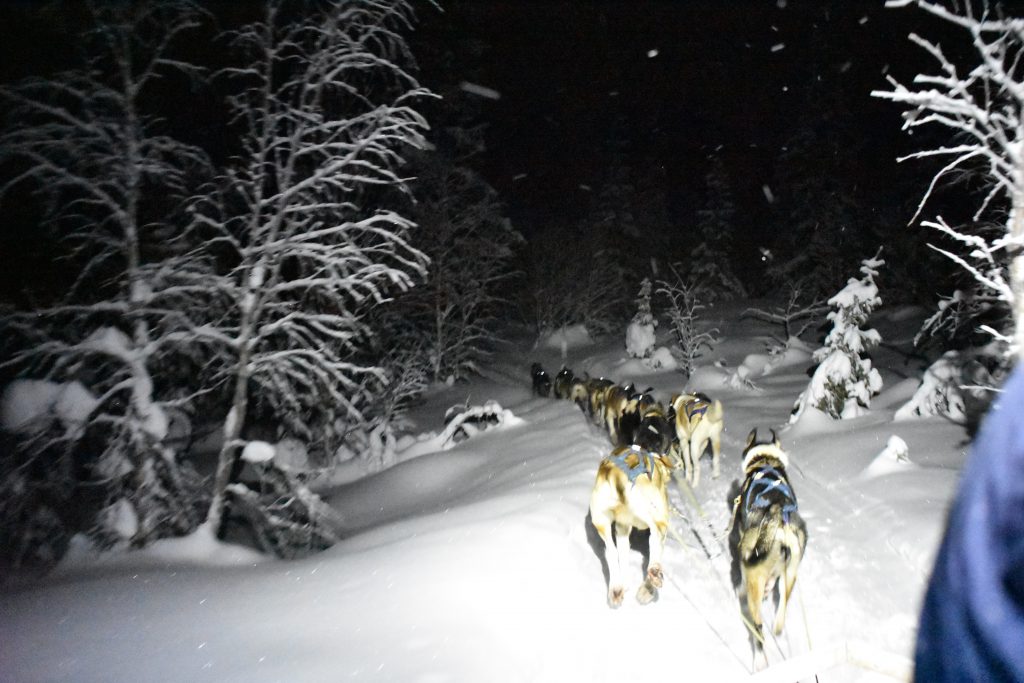
Late the following afternoon, we’d catch the sleeper to Stockholm, a journey that would begin in Arctic darkness and end in temperate greens. But before leaving Kiruna, we called in at our hotel’s spa. ‘Camp Ripan’ offered a full range of pampering, including an outdoor hot tub (which could somehow function at -20). Slightly stranger was a footbath, filled with magnetite nodules. In Lapland, it seems, iron ore has much to answer for: bankruptcies, battles, booms, disappearing towns, a bold railway and an unforgettable journey. And now, here it was, in one final service to humankind, beautifying feet.
DETAILS
John Gimlette was a guest of the Baltic Travel Company (0208 233 2875; www.baltictravelcompany.com. A 3-night package costs from £935pp (based on 2 sharing), including return flights from London, and train fares from Narvik to Kiruna.
For details of skiing, tours and the War Museum in Narvik, click on www.visitnarvik.com
John Gimlette is the author of ‘Elephant Complex: Travels in Sri Lanka’ (Riverrun £12.99)